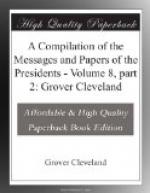But there are those who, conceding all this to be true, assume the ground that the true western boundary of Texas is the Nueces instead of the Rio Grande, and that therefore in marching our Army to the east bank of the latter river we passed the Texan line and invaded the territory of Mexico. A simple statement of facts known to exist will conclusively refute such an assumption. Texas, as ceded to the United States by France in 1803, has been always claimed as extending west to the Rio Grande or Rio Bravo. This fact is established by the authority of our most eminent statesmen at a period when the question was as well, if not better, understood than it is at present. During Mr. Jefferson’s Administration Messrs. Monroe and Pinckney, who had been sent on a special mission to Madrid, charged among other things with the adjustment of boundary between the two countries, in a note addressed to the Spanish minister of foreign affairs under date of the 28th of January, 1805, assert that the boundaries of Louisiana, as ceded to the United States by France, “are the river Perdido on the east and the river Bravo on the west,” and they add that “the facts and principles which justify this conclusion are so satisfactory to our Government as to convince it that the United States have not a better right to the island of New Orleans under the cession referred to than they have to the whole district of territory which is above described.” Down to the conclusion of the Florida treaty, in February, 1819, by which this territory was ceded to Spain, the United States asserted and maintained their territorial rights to this extent. In the month of June, 1818, during Mr. Monroe’s Administration, information having been received that a number of foreign adventurers had landed at Galveston with the avowed purpose of forming a settlement in that vicinity, a special messenger was dispatched by the Government of the United States with instructions from the Secretary of State to warn them to desist, should they be found there, “or any other place north of the Rio Bravo, and within




